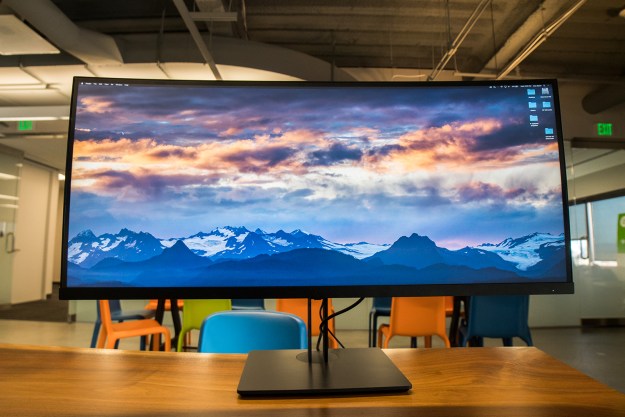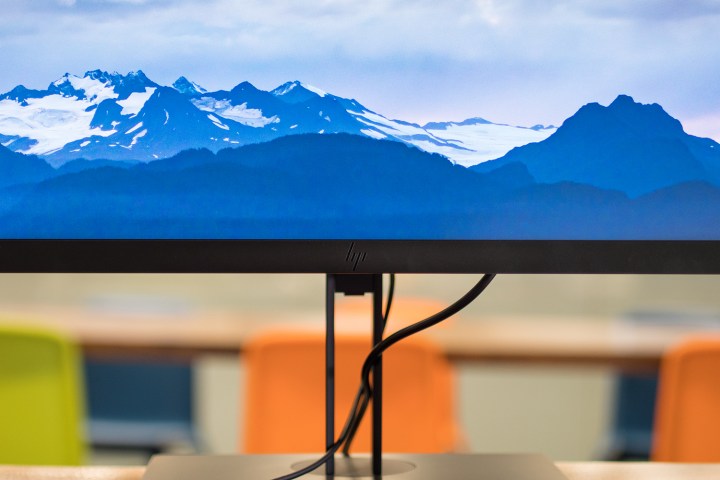
“The HP Z38c will suck you into its immersive screen.”
- Sleek industrial design
- Beautiful, accurate colors
- Highly adjustable stand
- Good connectivity
- No FreeSync support
- No speakers
Most people don’t want to spend $1,000 on a monitor. It’s not an easy thing to justify when you’ve already spent at least that much on your gaming rig or laptop. Yet the size and quality of your monitor can have a larger effect on your workday or gaming sessions than you might assume. If you’ve got the budget for it, why not go all in? If you’re thinking about picking up the $1,200 HP Z38c, you’re going all in.
Ultrawide, curved displays just keep getting sharper – and wider.
LG impressed everyone when it introduced its 38-inch wonder to the world in late 2016, but Dell did it better for $400 cheaper with its UltraSharp 38 Curved Monitor this year. HP is getting in the game with its own version, a massive, 38-inch curved display that competes spec-for-spec with the competition. While there are wider monitors out there, the Z38c is an impressive sight to behold with its 3,840 x 1,600 resolution and 21:9 aspect ratio. Ultrawide, curved displays have been around for a couple of years now, but they just keep getting sharper – and wider.
HP is the latecomer to the 38-inch monitor game this year, so let’s dig into the details to find out if the HP Z38c is worth going all-in.
Elegant, yet understated
‘Immersive’ is the buzzword often associated with ultrawide displays — and there definitely is an element of being absorbed within the width of the display. If you’ve never seen an ultrawide curved monitor in person, it’s an experience worth seeking out, especially for gamers and professionals.
The Z38c is one of the widest monitors out there, at 38 inches, and that kind of size gives you an odd 21:9 aspect ratio. To put it in perspective, it’s around the same height as a more standard, 27-inch 16:9 monitor. Its 3,840 x 1,600 resolution is the same as Dell’s UltraSharp 38 Curved Monitor, and LG’s 38UC99-W.
In the past couple of years, HP’s design team has been hitting it out of the park, whether you’re talking about its 2-in-1 PCs, or its straight-up laptops. This one is marked with the redesigned HP logo on the front, and aluminum wrapping that gives it a more premium feel than the LG or Dell competitors. It’s the same look you’ll find on smaller displays from HP, like the Z27 or Z24.
HP did a great job of keeping things simple and trim all around the display, from the bezels that house it to the stand that holds it in the air. The bezel on the bottom is slightly bigger than the Dell’s, but it’s nothing noticeable.
HP did a great job of keeping things simple and trim all around the display.
The Z38c has a large, square stand that provides heftiness to the build of the monitor. Both the stand and base are made of aluminum, which adds some weight, and gives the Z38c substantial tilt, height, and swivel action. The 38-inch display can swivel up to 45 degrees to both the left and right, which is 15 degrees more than the Dell, and the LG can’t turn at all. You really must tug on it to adjust, but you never feel like you’re going to break it — and that’s important when you’re handling $1,200 of pixels.
However, the stand does take up a rather large footprint on the desk, especially compared to something like the LG 38UC99’s tiny base. If you want to switch it out, or install the monitor on an arm, you can use the standard VESA mounting adapter to do so.
Plenty of ports — facing the wrong way
For I/O, you’ve got a wide swath of ports, including DisplayPort (1.2), an HDMI (2.0), three USB-A ports, and a single USB-C port. For good measure, you’ve also got a Kensington lock. It doesn’t have quite as many ports as what’s available on the Dell, but it’s got the same selection of ports — and it’s nice to see a USB-C included here. The LG doesn’t include that.
Most of these ports are on the back of the monitor, facing downward. Because the screen can’t rotate, access is particularly difficult — and with how wide this thing is, you’ll need to clear your desk completely to get a look at them. Once you’ve got everything plugged in, it makes for a clean setup. Just hope that you don’t have to switch them out regularly.
However, the Z38c does give you a USB-A and USB-C port on the left side of the monitor, for easy access. That means you can add peripherals without much hassle.
A modern monitor with old-school menus
You’ll find the controls on the Z38c just where’d you expect — on the right, on the bottom side of the display. You get a power button and four control buttons. While the power button is a bit too sensitive for our liking, the four control buttons are clicky, and easy to use.
The menus will remind you a bit of old televisions.
Outside of brightness, you probably won’t have to dig into the settings much, but HP does offer access to extensive color options and display modes. For viewing modes, you get toggles for Night, Low Blue Light, Reading, HP Enhance+, and Photo. As for color options, you do have the ability to minutely adjust color for RGB.
They’re not the prettiest menus in the world, though. They’ll remind you a bit of old television settings. Dell’s selection and design takes the cake here, but the Z38’s menus are functional enough.
Do you value silence?
The Z38c doesn’t have any built-in speakers. That’s probably not a big deal for most people who’ll want to use external speakers, but it’s something both competitors include that HP has ditched. If you want a monitor with speakers, you’ll have to look elsewhere.
Pre-calibration display quality
If you’ve checked out the other two 38-inch ultrawide monitors on the market, the HP Z38c should look familiar. It’s got the same 3,840 x 1,600 screen resolution, which is still the highest you’ll on any ultrawide monitor. It’s also scores a tiny bit behind the others in terms of max brightness, contrast ratio, and display gamut (percentage of RGB) — though not by enough to notice.
These monitors don’t have the insane contrast ratio of something like the BenQ EX3200R or Samsung CF791 — but then again, those aren’t 38 inches large. The HP Z38c came in at 310 nits of brightness, which isn’t all that bright, but it stays on pace with the 38-inch Dell and LG.
HP claims the Z38c comes with “factory color calibration” that promises consistent and accurate colors. In our testing, the HP Z38 fares extremely well on that promise, getting an average color error of 2.03 before we calibrated the display. Colors appear bright and bold, making things like watching movies and playing games completely immersive.
Colors appear bright and bold, making movies and games immersive.
Without FreeSync support and just a 60 Hz refresh rate, this is far from the ultimate gaming monitor, but it’ll satisfy most gamers. For a serious ultrawide gaming monitor you’ll want to look toward something like the Acer Predator Z35, which boasts a refresh rate of 200Hz, or the Samsung CF791, which offers 144Hz.
In our testing, the display handled 95 percent of the sRGB color gamut, and 74 percent of AdobeRGB — which isn’t the absolute best, but is certainly good. Again, that lags a bit behind the LG and the Dell, but you probably wouldn’t be able to tell the difference. Right out of the box, the Z38c is great for editing photos and video without having to worry that the display is lying to you.
Post-calibration image quality
We calibrated the screen on the Z38c and didn’t see any serious changes. Color error went down by a bit, which is great, but there’s not much else here that’s different to report. Overall, HP has done a good job of making sure the display is very close to calibrated right out of the box.
Warranty information
HP comes with a standard 3-year warranty and options for extended protection to ensure you get your money’s worth.
Our Take
Curved ultrawide monitors still have a bit of novelty to them, but it’s hardly a gimmick. The HP Z38c is a beautiful, massive monitor — there’s no doubt about that. The image quality is on par with its competitors, and the build of the stand and base make it stand out.
You can get a higher resolution monitor with higher contrast elsewhere, but for its size, the HP Z38 is the best you can buy.
Is there a better alternative?
There are two competitors to the HP Z38 — the Dell Ultrasharp 38, and LG’s 38UC99. The image quality is equal across the board, both in terms of resolution and refresh rate. Both the HP and the Dell offer their monitors at a highly discounted price compared to the LG (around $1,200, compared to $1,500), which mostly takes the LG out of the race. The feature that the LG has over the others is FreeSync support, which would make it the possible pick for gamers.
Between the Dell and HP, it’s nearly a tossup. We like the sleek design of the stand and base of the HP Z38c, compared to the more standard, corporate feel of the Dell. The HP Z38 also offers slightly better swivel and height adjustment, while the Dell gives you more USB ports, and a marginally lower price tag ($30 if you buy at MSRP). Both are great ultrawide monitors that are the best in their class.
If you also look at smaller monitors, Samsung’s CF791 remains our top pick. Its incredible image quality and slick design outperform these larger screens, and it can be purchased for as little as $750 online.
How long will it last?
When you buy a monitor, you should expect it to last a long time — especially when it costs over $1,000. The HP Z38 should last you many years, especially considering how sturdy the stand is.
Should you buy it?
Yes. The HP Z38 is big, beautiful ultrawide monitor that ties the Dell Ultrasharp 38 for the best of its kind.
Editors' Recommendations
- The 5 best ultrawide monitors for gaming and work in 2024
- HP unveils new IPS Black monitor with one key new feature
- HP’s new Z studio monitors have a pop-up 4K webcam for crisp video calls
- Best curved gaming monitors
- Dell reveals world’s first 40-inch, ultrawide, curved 5K monitor for CES








